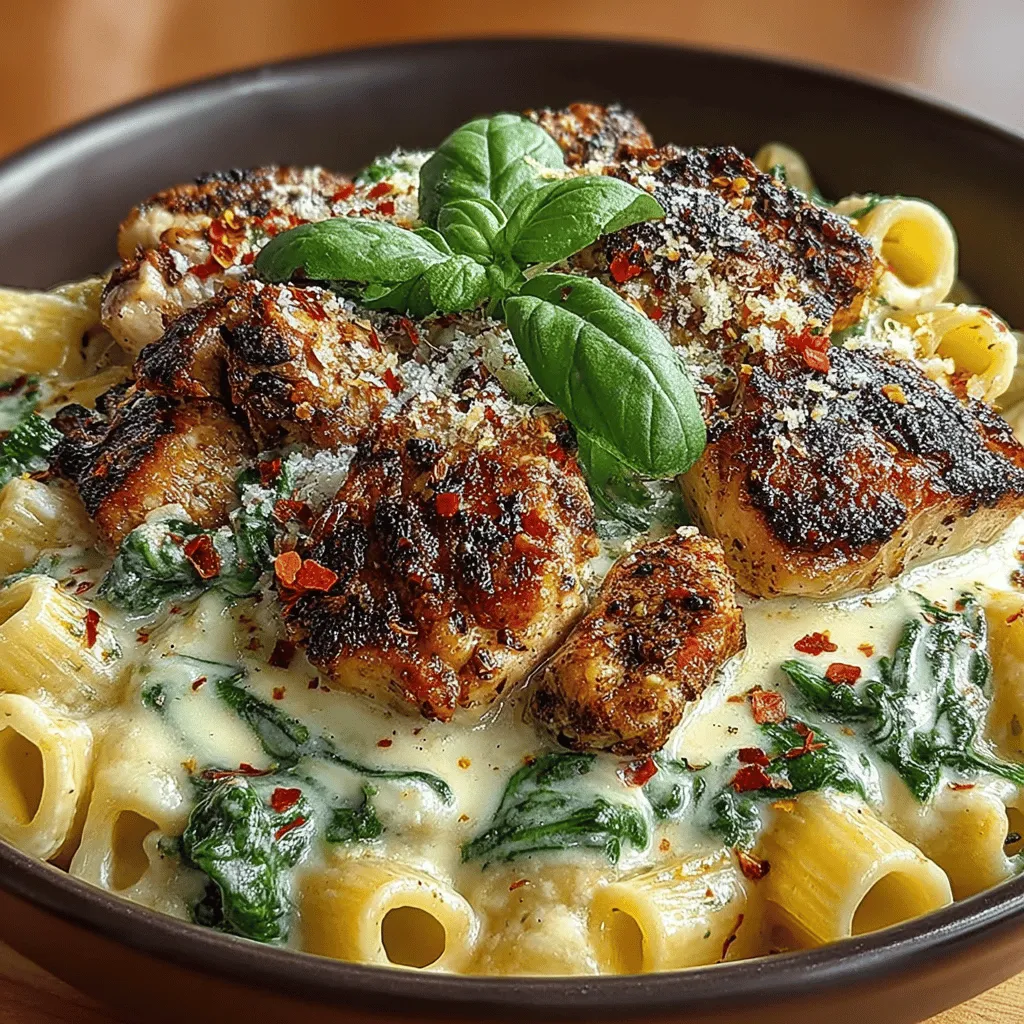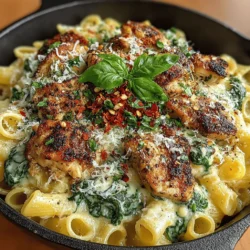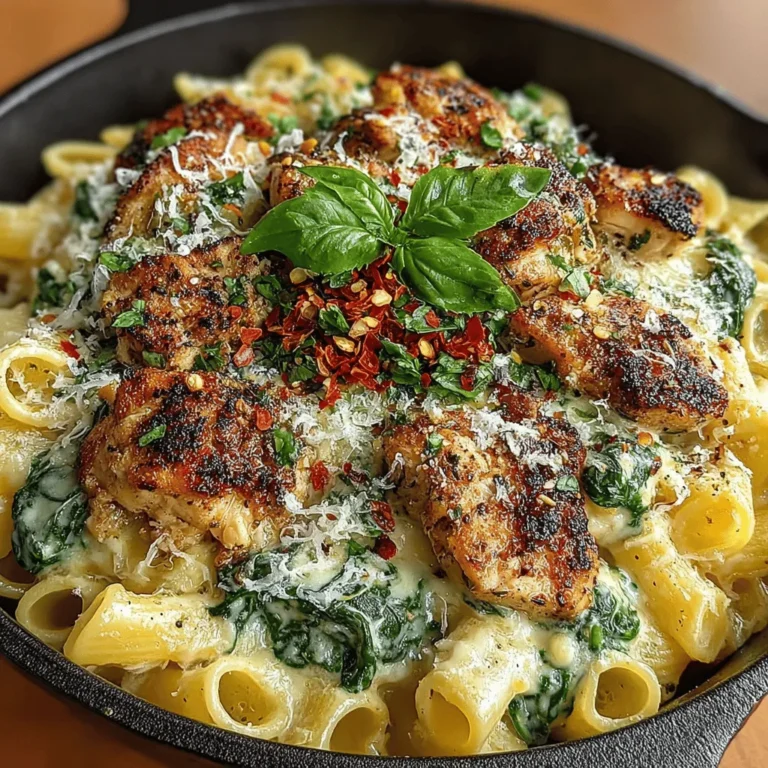Introduction
Welcome to the world of delicious, home-cooked meals! Today, we’re diving into a comforting and flavorful dish that is perfect for a busy weeknight or a cozy weekend dinner: Creamy Chicken and Spinach Skillet Pasta. This recipe combines tender chicken with fresh spinach and a rich, creamy sauce, enveloping al dente pasta for a truly satisfying meal. Whether you are an experienced cook or just starting your culinary journey, this dish is not only simple to prepare but also packed with nutrients and taste. Let’s explore the ingredients, method, and more about why this dish deserves a spot on your dinner table.
Ingredients
– 8 ounces of pasta (penne or fusilli)
– 1 pound of boneless, skinless chicken breasts, cut into bite-sized pieces
– 2 cups fresh spinach, roughly chopped
– 3 cloves garlic, minced
– 1 medium onion, diced
– 1 cup heavy cream
– 1 cup chicken broth
– 1/2 cup grated Parmesan cheese
– 2 tablespoons olive oil
– Salt and pepper to taste
– Optional: red pepper flakes for heat
Instructions
1. Cook the Pasta: Bring a large pot of salted water to a boil. Add the pasta and cook according to package instructions until al dente. Drain and set aside.
2. Sauté the Chicken: In a large skillet, heat the olive oil over medium-high heat. Add the chicken pieces and season with salt and pepper. Cook for about 6-7 minutes, or until the chicken is golden brown and cooked through. Remove the chicken from the skillet and set aside.
3. Sauté the Aromatics: In the same skillet, add the diced onion and minced garlic. Sauté for 2-3 minutes until the onion is translucent and the garlic is fragrant.
4. Create the Creamy Sauce: Pour in the chicken broth and bring it to a simmer. Then add the heavy cream, stirring to combine. Let it simmer for about 3-5 minutes until the sauce has thickened slightly.
5. Combine Ingredients: Add the cooked chicken back to the skillet along with the chopped spinach. Stir until the spinach wilts and everything is well combined.
6. Mix in the Pasta: Add the drained pasta to the skillet, tossing everything together. Stir in the grated Parmesan cheese, and season with additional salt, pepper, and red pepper flakes if desired.
7. Serve: Remove from heat and serve immediately, garnished with extra Parmesan if you like.
Understanding the Ingredients
Exploring the Core Ingredients
– Importance of Pasta in the Dish: The choice of pasta not only affects the texture but also how well the sauce clings to each piece. Penne and fusilli are ideal for this creamy sauce.
– The Role of Chicken: Protein and Flavor: Chicken breast provides a lean source of protein while absorbing the flavors of the sauce.
– Spinach: Nutritional Benefits and Flavor Profile: Fresh spinach adds vibrant color and essential nutrients, including vitamins A and C, while contributing a mild, earthy flavor.
– Garlic and Onion: Aromatics that Enhance the Dish: These aromatics form the flavor base, creating a savory foundation for the sauce.
– Heavy Cream: Creating the Creamy Texture: Heavy cream is essential for achieving that rich, luxurious texture that makes this dish so indulgent.
– Chicken Broth: Adding Depth of Flavor: A good-quality chicken broth enhances the overall taste, adding complexity to the sauce.
– Parmesan Cheese: The Finishing Touch: Parmesan not only enriches the flavor but also helps thicken the sauce when melted.
– Olive Oil and Seasonings: Enhancing the Overall Taste: Olive oil adds richness and aids in sautéing, while seasonings elevate the dish’s flavor profile.
Step-by-Step Cooking Process
Cooking the Pasta to Perfection
– Choosing the Right Pasta: Penne or fusilli work best for their ability to hold onto the creamy sauce.
– The Importance of Al Dente Texture: Cooking pasta al dente ensures it maintains a slight firmness, which prevents it from becoming mushy when combined with the sauce.
– Tips for Salting Pasta Water: Properly salting the water enhances the pasta’s flavor and is essential for a well-seasoned dish.
Sautéing the Chicken
– Choosing the Right Skillet: A large, heavy skillet is ideal for even cooking and preventing overcrowding.
– Seasoning Tips for Maximum Flavor: Season the chicken well before cooking to ensure every bite is flavorful.
– Cooking Time and Temperature Guidelines: Cook the chicken until it reaches an internal temperature of 165°F for safety while retaining moisture.
Sautéing Aromatics: Onion and Garlic
– Why Sautéing Matters: Sautéing releases the natural sugars in the onion and garlic, enhancing their flavors.
– Cooking Times and Techniques for Perfect Aromatics: Sauté until the onion is just translucent; overcooking can lead to bitterness.
Creating the Creamy Sauce
– Balancing Chicken Broth and Heavy Cream: The ratio of broth to cream is crucial for achieving the desired consistency.
– Tips for Achieving the Right Consistency: Allow the sauce to simmer to thicken naturally; avoid using high heat to prevent separation.
– The Importance of Simmering: Simmering allows the flavors to meld beautifully, creating a harmonious sauce that coats the pasta perfectly.

Combining Ingredients for a Flavorful Dish
Techniques for Wilting Spinach
Wilting spinach is a straightforward process that enhances the texture and flavor of the dish. Start by adding fresh spinach to your skillet when the chicken is nearly done cooking. This will allow the spinach to absorb some of the chicken juices, adding depth to its flavor. Stir the spinach frequently to ensure even wilting, which should take just a few minutes. Overcooking can lead to a mushy texture, so keep an eye on it.
The Role of Parmesan in Sauce Integration
Parmesan cheese is not only a flavor enhancer but also plays a crucial role in creating a creamy sauce. As you incorporate the cheese, it melts into the sauce, thickening it and adding a rich, umami taste. For the best results, use freshly grated Parmesan cheese, as pre-packaged varieties may not melt as smoothly. If the sauce seems too thick after adding the cheese, a splash of pasta water can help achieve the desired consistency.
Adjusting Seasonings for Personal Taste
When it comes to seasoning, personal preference plays a significant role. Start with the basic salt and pepper, but feel free to experiment with garlic powder, red pepper flakes, or Italian herbs like oregano and thyme. Tasting as you go will allow you to adjust the flavors to your liking, ensuring that the dish is perfectly suited to your palate.
Incorporating Pasta into the Dish
Tossing Techniques for Even Coating
To ensure that the pasta is evenly coated with the creamy sauce, use a gentle tossing method. Instead of stirring vigorously, which can break the pasta, use a pair of tongs or a pasta fork to lift and fold the pasta into the sauce. This method helps to incorporate the sauce without damaging the noodles, resulting in a beautifully coated dish.
How to Adjust Sauce Thickness
If you find that your sauce is too thick, you can easily adjust it. Gradually add small amounts of pasta water, which contains starch and will help the sauce adhere better to the pasta. On the other hand, if your sauce is too thin, let it simmer for a few extra minutes to reduce and thicken. This simple adjustment can significantly enhance the overall texture of the dish.
Presentation of the Dish
Plating Tips for an Elegant Presentation
To elevate the dining experience, consider your plating technique. Using shallow bowls can create a more modern look, while deep plates can hold more sauce and pasta. For an appealing presentation, carefully twirl the pasta into a nest shape in the center of the bowl or plate. This creates height and visual interest.
Garnishing with Fresh Basil and Parmesan
A sprinkle of fresh basil not only adds a pop of color but also enhances the flavor profile of your dish. Additionally, a light dusting of freshly grated Parmesan can add a touch of elegance. For an extra flair, consider adding a few basil leaves on top as a garnish.
Adding a Touch of Olive Oil for Visual Appeal
Drizzling a small amount of high-quality olive oil over the finished dish before serving can enhance both the flavor and appearance. The glossy finish from the olive oil makes the dish look more inviting and appetizing.
Nutritional Information and Benefits
Caloric Breakdown of Creamy Chicken and Spinach Skillet Pasta
Understanding the nutritional aspects of your meal can help you make informed choices. On average, a serving of Creamy Chicken and Spinach Skillet Pasta contains approximately 600-700 calories, depending on the portion size and specific ingredients used.
Protein Content from Chicken and Cheese
This dish is a good source of protein, primarily from the chicken and Parmesan cheese. A typical serving can provide about 30-40 grams of protein, making it a satisfying option for those looking to maintain or build muscle.
Nutrients from Spinach and Garlic
Spinach is packed with essential vitamins and minerals, including Vitamin A, Vitamin K, and iron. Garlic not only adds flavor but also has numerous health benefits, including boosting the immune system and reducing inflammation.
Healthy Fats from Olive Oil
The olive oil used in the dish contributes healthy monounsaturated fats, which are beneficial for heart health. Incorporating olive oil into your diet can help lower bad cholesterol levels while promoting good cholesterol.
Variations and Customizations
Exploring Different Pasta Options
Feel free to experiment with different types of pasta to suit your dietary preferences. Whole wheat pasta adds more fiber, while gluten-free options like rice or chickpea pasta can cater to those with dietary restrictions. Each variation can alter the dish’s texture and flavor profile, offering new experiences.
Adding More Vegetables: Bell Peppers, Mushrooms, or Zucchini
Incorporating additional vegetables can enhance the nutritional value and flavor of your dish. Bell peppers add sweetness, mushrooms provide earthiness, and zucchini offers a fresh crunch. Simply sauté them along with the chicken for added color and taste.
Protein Alternatives for Dietary Preferences
For those who prefer alternatives to chicken, shrimp or tofu can be excellent substitutes. Shrimp cooks quickly and adds a seafood twist, while tofu absorbs surrounding flavors, making it a great option for vegetarians or vegans.
Adjusting the Creaminess
If you want to make the dish lighter, consider using Greek yogurt or reduced-fat cream instead of heavy cream. For a dairy-free option, coconut cream or cashew cream can provide the desired creaminess without lactose.
Conclusion
Creamy Chicken and Spinach Skillet Pasta is more than just a meal; it’s a comforting dish that brings family and friends together around the table. With its easy preparation and rich flavors, this recipe is sure to become a favorite in your household. Whether you choose to keep it classic or customize it to your tastes, this dish offers flexibility and satisfaction in every bite. Enjoy making and sharing this delightful pasta dish as you embrace the joy of cooking at home.


